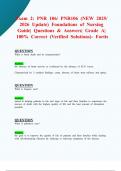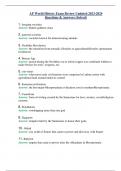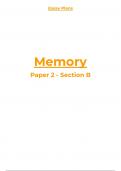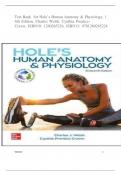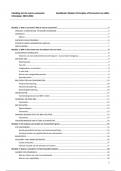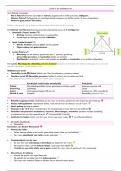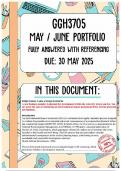Biopsychology of Emotion: Introduction
Early Landmarks in the Biopsychological Investigation of Emotion
LO 17.1 Summarize the major events in the history of research on the biopsychology
of emotion:
Darwin’s theory of the evolution of emotion
• Expressions of emotion evolve from behaviors that indicate what an animal is likely to do
next.
• If the signals provided by such behaviors benefit the animal that displays them, they will
evolve in ways that enhance their communicative function, and their original function may be
lost.
• Opposite messages are often signaled by opposite movements and postures, an idea
called the principle of antithesis.
James-Lange theory and Cannon-Bard theory
According to the James-lange theory, emotion-inducing sensory stimuli are received and
interpreted by the cortex, which triggers changes in the visceral organs via the autonomic
nervous system and in the skeletal muscles via the somatic nervous system. Then, the
autonomic and somatic responses trigger the experience of emotion in the brain. James and
Lange argued that the autonomic activity and behavior that are triggered by the emotional
event (e.g., rapid heartbeat and running away) produce the feeling of emotion, not vice
versa.
According to the Cannon-Bard theory, emotional stimuli have two independent excitatory
effects: They excite both the feeling of emotion in the brain and the expression of emotion in
the autonomic and somatic nervous systems. That is, the Cannon-Bard theory, in contrast to
the James-Lange theory, views emotional experience and emotional expression as parallel
processes that have no direct causal relation.
Both extreme positions have proved to be incorrect. On the one hand, it seems that the
autonomic and somatic feedback is not necessary for the experience of emotion. On the
other hand, there have been numerous reports that autonomic and somatic responses to
emotional stimuli can influence emotional experience.
The modern biopsychological view
According to this view, each of the three principal factors in an emotional response—the
perception of the emotion-inducing stimulus, the autonomic and somatic responses to the
stimulus, and the experience of the emotion—can influence the other two.
,Sham rage
Bard referred to the exaggerated, poorly directed aggressive responses of decorticate
animals as sham rage. Sham rage can be elicited in cats whose cerebral hemispheres have
been removed down to, but not including the hypothalamus; but it cannot be elicited if the
hypothalamus is also removed. On the basis of this observation, Bard concluded that the
hypothalamus is critical for the expression of aggressive responses and that the function of
the cortex is to inhibit and direct these responses.
Limbic system and emotion
Limbic system: the amygdala, mammillary body, hippocampus, fornix, cingulate cortex,
septum, olfactory bulb, and hypothalamus. Papez proposed that emotional states are
expressed through the action of the other structures of the circuit on the hypothalamus and
that they are experienced through their action on the cortex
Klüver-Bucy syndrom
The Klüver-Bucy syndrome, includes the following behaviors: the consumption of almost
anything that is edible, increased sexual activity often directed at inappropriate objects, a
tendency to repeatedly investigate familiar objects, a tendency to investigate objects with the
mouth, and a lack of fear. In primates, most of the symptoms of the Klüver-Bucy syndrome
appear to result from damage to the amygdala, a structure that has played a major role in
research on emotion
, Emotions and the Autonomic Nervous System
LO 17.2 Summarize the research on the relationship between the autonomic nervous
system and emotions.
Emotional specificity of the autonomic nervous system
The experimental evidence suggests that the specificity of ANS reactions lies somewhere
between the extremes of total specificity and total generality. On one hand, ample evidence
indicates that not all emotions are associated with the same pattern of ANS activity; on the
other, there is no evidence that each emotion is characterized by a distinct pattern of ANS
activity.
Polygraphy
Polygraphy (more commonly known as the “lie detector test”) is a method of interrogation
that employs ANS indexes of emotion to infer the truthfulness of a person’s responses.
The usual interrogation method is the control-question technique, in which the
physiological response to the target question (e.g., “Did you steal that purse?”) is compared
with the physiological responses to control questions whose answers are known (e.g., “Have
you ever been in jail before?”).
In real-life situations, questions such as “Did you steal that purse?” are likely to elicit an
emotional reaction from all suspects. The guilty-knowledge technique, circumvents this
problem. In order to use this technique, the polygrapher must have a piece of information
concerning the crime that would be known only to the guilty person. Innocent suspects,
because they have no knowledge of the crime, react to all such details in the same way; the
guilty react differentially.
Emotions and Facial Expression
LO 17.3 Describe research on the facial expression of emotions.
Universality of facial expression
Several studies have found that people of different cultures make similar facial expressions
in similar situations and that they can correctly identify the emotional significance of facial
expressions displayed by people from cultures other than their own.
Primary facial expressions
Ekman and Friesen concluded that the facial expressions of the following six emotions are
primary: surprise, anger, sadness, disgust, fear, and happiness.
Facial feedback hypothesis
Is there any truth to the old idea that putting on a happy face can make you feel better?
Research suggests that there is. The hypothesis that our facial expressions influence our
emotional experience is called the facial feedback hypothesis.
Voluntary control of facial expressions
There are two ways of distinguishing true expressions from false ones. First,
microexpressions (brief facial expressions) of the real emotion often break through the false
one. Second, there are often subtle differences between genuine facial expressions and
false ones that can be detected by skilled observers. The two facial muscles that are


